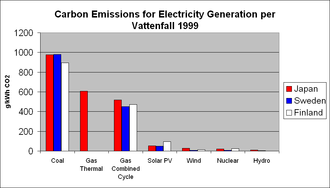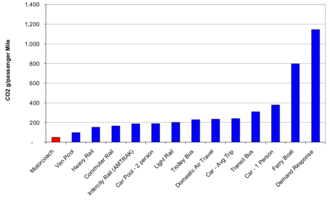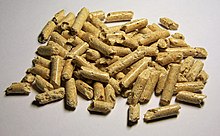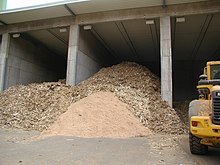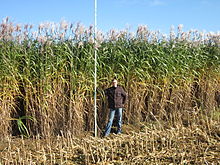A carbon footprint is historically defined as the total emissions caused by an individual, event, organization, or product, expressed as carbon dioxide equivalent. Greenhouse gases (GHGs), including carbon dioxide,
can be emitted through land clearance and the production and
consumption of food, fuels, manufactured goods, materials, wood, roads,
buildings, transportation and other services.
In most cases, the total carbon footprint cannot be exactly
calculated because of inadequate knowledge of and data about the complex
interactions between contributing processes, including the influence of
natural processes that store or release carbon dioxide. For this
reason, Wright, Kemp, and Williams, have suggested to define the carbon
footprint as:
A measure of the total amount of carbon dioxide (CO2) and methane (CH4)
emissions of a defined population, system or activity, considering all
relevant sources, sinks and storage within the spatial and temporal
boundary of the population, system or activity of interest. Calculated
as carbon dioxide equivalent using the relevant 100-year global warming potential (GWP100).
Visual representation of carbon footprint.
Most of the carbon footprint emissions for the average U.S. household
come from "indirect" sources, e.g. fuel burned to produce goods far
away from the final consumer. These are distinguished from emissions
which come from burning fuel directly in one's car or stove, commonly
referred to as "direct" sources of the consumer's carbon footprint.
The concept name of the carbon footprint originates from ecological footprint, discussion, which was developed by William E. Rees and Mathis Wackernagel
in the 1990s. This accounting approach compares how much people demand
compared to what the planet can renew. This allows to assess the number
of "earths" that would be required if everyone on the planet consumed
resources at the same level as the person calculating their ecological
footprint. The carbon Footprint is one part of the ecological footprint.
The carbon part was popularized by a large campaign of BP in 2005.
In 2007, carbon footprint was used as a measure of carbon emissions to
develop the energy plan for City of Lynnwood, Washington. Carbon
footprints are more focused than ecological footprints since they
measure merely emissions of gases that cause climate change into the
atmosphere.
Carbon footprint is one of a family of footprint indicators, which also includes water footprint and land footprint.
Measuring carbon footprints
An individual's, nation's, or organization's carbon footprint can be measured by undertaking a GHG emissions assessment, a life cycle assessment, or other calculative activities denoted as carbon accounting. Once the size of a carbon footprint is known, a strategy can be devised to reduce it, e.g. by technological developments, energy efficiency improvements, better process and product management, changed Green Public or Private Procurement (GPP), carbon capture, consumption strategies, carbon offsetting and others.
For calculating personal carbon footprints, several free online carbon footprint calculators exist,
including a few supported by publicly available peer-reviewed data and
calculations including the University of California, Berkeley's
CoolClimate Network research consortium and CarbonStory.These websites ask you to answer more or less detailed questions about
your diet, transportation choices, home size, shopping and recreational
activities, usage of electricity, heating, and heavy appliances such as
dryers and refrigerators, and so on. The website then estimates your
carbon footprint based on your answers to these questions. A systematic
literature review was conducted to objectively determine the best way to
calculate individual/household carbon footprints. This review
identified 13 calculation principles and subsequently used the same
principles to evaluate the 15 most popular online carbon footprint
calculators. A recent study’s results by Carnegie Mellon's Christopher
Weber found that the calculation of carbon footprints for products is
often filled with large uncertainties. The variables of owning
electronic goods such as the production, shipment, and previous
technology used to make that product, can make it difficult to create an
accurate carbon footprint. It is important to question, and address the
accuracy of Carbon Footprint techniques, especially due to its
overwhelming popularity.
Calculating the carbon footprint of an industry, product, or
service is a complex task, as stated earlier. One tool industry uses is Life-cycle assessment (LCA), where carbon footprint may be one of many factors taken into consideration when assessing a product or service. The International Organization for Standardization has a standard called ISO 14040:2006 that has the framework for conducting an LCA study. Another method is through the Greenhouse Gas Protocol, a set of standards for tracking GHG emissions.
It should also be noted that predicting the carbon footprint of a
process is also possible through estimations using the above standards.
By using Emission intensities/Carbon intensities
and the estimated annual use of a fuel, chemical, or other inputs, the
carbon footprint can be estimated while a process is being
planned/designed.
Direct carbon emissions
Direct carbon emissions come from sources that are directly from the site that is producing a product. These emissions can also be referred to as scope 1 and scope 2 emissions.
Scope 1 emissions are emissions that are directly emitted from the site of the process or service.
An example for industry would be the emissions related to burning a
fuel on site. On the individual level, emissions from personal vehicles
or gas burning stoves would fall under scope 1.
Scope 2 emissions are the other emissions related to purchased electricity, heat, and/or steam used on site. In the US, the EPA has broken down electricity emission factors by state.
Indirect carbon emissions
Indirect
carbon emissions are emissions from sources upstream or downstream from
the process being studied, also known as scope 3 emissions.
Examples of upstream, indirect carbon emissions may include:
- Transportation of materials/fuels
- Any energy used outside of the production facility
- Wastes produced outside of the production facility
Examples of downstream, indirect carbon emissions may include:
- Any end-of-life process or treatments
- Product and waste transportation
- Emissions associated with selling the product
Ways to reduce personal carbon footprint
The most common way to reduce the carbon footprint of humans is to Reduce, Reuse, Recycle, Refuse.
This can also be done by using reusable items such as thermoses
for daily coffee or plastic containers for water and other cold
beverages rather than disposable ones. If that option isn't available,
it is best to properly recycle the disposable items after use. When one
household recycles at least half of their household waste, they can save
1.2 tons of carbon dioxide annually.
Another easy option is to drive less. By walking or biking to the
destination rather than driving, not only is a person going to save
money on gas, but they will be burning less fuel and releasing fewer
emissions into the atmosphere. However, if walking is not an option, one
can look into carpooling or mass transportation options in their area.
Yet another option for reducing the carbon
footprint of humans is to use less air conditioning and heating in the
home. By adding insulation to the walls and attic of one's home, and
installing weather stripping or caulking
around doors and windows one can lower their heating costs more than 25
percent. Similarly, one can very inexpensively upgrade the "insulation"
(clothing) worn by residents of the home.
For example, it's estimated that wearing a base layer of long underwear
(top and bottom) made from a lightweight, super insulating fabric like
microfleece (aka Polartec®, Capilene®) can conserve as much body
heat as a full set of clothing, allowing a person to remain warm with
the thermostat lowered by over 5 °C.
These measures all help because they reduce the amount of energy needed
to heat and cool the house. One can also turn down the heat while
sleeping at night or away during the day, and keep temperatures moderate
at all times. Setting the thermostat just 2 degrees lower in winter and
higher in summer could save about 1 ton of carbon dioxide each year.
Another option is to stop having children, or at any rate to have
fewer of them! World population has increased from three billion to
nine billion in fifty years. Each of those nine billion people generate
their own carbon footprint, small or large. Can we really afford to
carry on expanding world population? If you think we shouldn't, you
could do your part by having fewer, or no, children.
Choice of diet is a major influence on a person's carbon
footprint. Animal sources of protein (especially red meat), rice
(typically produced in high methane-emitting paddies), foods transported
long distance and/or via fuel-inefficient transport (e.g., highly
perishable produce flown long distance) and heavily processed and
packaged foods are among the major contributors to a high carbon diet.
Scientists at the University of Chicago have estimated
"that the average American diet – which derives 28% of its calories
from animal foods – is responsible for approximately one and a half more
tonnes of greenhouse gasses – as CO
2 equivalents – per person, per year than a fully plant-based, or vegan, diet." Their calculations suggest that even replacing one third of the animal protein in the average American's diet with plant protein (e.g., beans, grains) can reduce the diet's carbon footprint by half a tonne. Exchanging two thirds of the animal protein with plant protein is roughly equivalent to switching from a Toyota Camry to a Prius. Finally, throwing food out not only adds its associated carbon emissions to a person or household's footprint, it adds the emissions of transporting the wasted food to the garbage dump and the emissions of food decomposition, mostly in the form of the highly potent greenhouse gas, methane.
2 equivalents – per person, per year than a fully plant-based, or vegan, diet." Their calculations suggest that even replacing one third of the animal protein in the average American's diet with plant protein (e.g., beans, grains) can reduce the diet's carbon footprint by half a tonne. Exchanging two thirds of the animal protein with plant protein is roughly equivalent to switching from a Toyota Camry to a Prius. Finally, throwing food out not only adds its associated carbon emissions to a person or household's footprint, it adds the emissions of transporting the wasted food to the garbage dump and the emissions of food decomposition, mostly in the form of the highly potent greenhouse gas, methane.
The carbon handprint movement emphasizes individual forms of
carbon offsetting, like using more public transportation or planting
trees in deforested regions, to reduce one's carbon footprint and
increase their "handprint."
Centre for Environment Education
(CEE), Ahmedabad, India - a Centre of Excellence in Environmental
Education has played a leading role in global efforts at strengthening
the role of education in sustainable development over the years. The
Handprint
concepts signifying positive action and commitment towards
Sustainability was launched at one of CEE's conferences “The 4th
International Conference on Environmental Education”, in Ahmedabad, in
2007. The Handprint is being used around the world to strengthen action towards fulfillment of the UN SDGs.
A July 2017 study published in Environmental Research Letters
argued that the most significant way individuals could mitigate their
own carbon footprint is to have one less child (58.6 tonnes CO2-equivalent per year), followed by living car-free (2.4 CO2-equivalent per year), forgoing air travel (1.6 CO2-equivalent per trans-Atlantic trip) and adopting a plant-based diet (0.8 CO2-equivalent per year).
The study also found that most government resources on climate change
focus on actions that have a relatively modest effect on greenhouse gas
emissions, and concludes that "a US family who chooses to have one fewer
child would provide the same level of emissions reductions as 684
teenagers who choose to adopt comprehensive recycling for the rest of
their lives".
SDG Handprint Lab
SDG Handprint Lab of Centre for Environment Education
(CEE) is an initiative that involves university students in direct
Handprint action towards SDGs and targets through a unique pedagogy that
makes them understand the complex and transdisciplinary nature of
sustainable development in the context of local area sustainability
issues. The programme builds a platform for discussion, and creates
conditions for their active engagement and using their skills and
knowledge to conduct research and executing Handprint activities.
Exploring the themes of the SDGs is an excellent way to get the students
to link their education and skill with real life problems in the wider
community and environment.
Ways to reduce industry's carbon footprint
A product, service, or company’s carbon footprint can be affected by several factors including, but not limited to:
- Energy sources
- Offsite electricity generation
- Materials
These factors can also change with location or industry. However,
there are some general steps that can be taken to reduce carbon
footprint on a larger scale.
In 2016, the EIA reported that in the US electricity is
responsible for roughly 37% of Carbon Dioxide emissions, making it a
potential target for reductions.
Possibly the cheapest way to do this is through energy efficiency
improvements. The ACEEE reported that energy efficiency has the
potential to save the US over 800 billion kWh per year, based on 2015
data. Some potential options to increase energy efficiency include, but are not limited to:
- Waste heat recovery systems
- Insulation for large buildings and combustion chambers
- Technology upgrades, ie different light sources, lower consumption machines
Carbon Footprints from energy consumption can be reduced through the development of alternative energy projects, such as solar and wind energy, which are renewable resources.
Reforestation, the restocking of existing forests or woodlands that have previously been depleted, is an example of Carbon Offsetting, the counteracting of carbon dioxide emissions with an equivalent reduction of carbon dioxide in the atmosphere. Carbon offsetting can reduce a companies overall carbon footprint by offering a carbon credit.
A life cycle
or supply chain carbon footprint study can provide useful data which
will help the business to identify specific and critical areas for
improvement. By calculating or predicting a process’ carbon footprint
high emissions areas can be identified and steps can be taken to reduce
in those areas.
Schemes to reduce carbon emissions: Kyoto Protocol, carbon offsetting, and certificates
Carbon
dioxide emissions into the atmosphere, and the emissions of other GHGs,
are often associated with the burning of fossil fuels, like natural
gas, crude oil and coal. While this is harmful to the environment, carbon offsets can be purchased in an attempt to make up for these harmful effects.
The Kyoto Protocol
defines legally binding targets and timetables for cutting the GHG
emissions of industrialized countries that ratified the Kyoto Protocol.
Accordingly, from an economic or market perspective, one has to
distinguish between a mandatory market and a voluntary market. Typical for both markets is the trade with emission certificates:
- Certified Emission Reduction (CER)
- Emission Reduction Unit (ERU)
- Verified Emission Reduction (VER)
Mandatory market mechanisms
To reach the goals defined in the Kyoto Protocol, with the least economical costs, the following flexible mechanisms were introduced for the mandatory market:
The CDM and JI mechanisms requirements for projects which create a supply of emission reduction instruments, while Emissions Trading allows those instruments to be sold on international markets.
- Projects which are compliant with the requirements of the CDM mechanism generate Certified Emissions Reductions (CERs).
- Projects which are compliant with the requirements of the JI mechanism generate Emission Reduction Units (ERUs).
The CERs and ERUs can then be sold through Emissions Trading. The demand for the CERs and ERUs being traded is driven by:
- Shortfalls in national emission reduction obligations under the Kyoto Protocol.
- Shortfalls amongst entities obligated under local emissions reduction schemes.
Nations which have failed to deliver their Kyoto emissions reductions obligations can enter Emissions Trading
to purchase CERs and ERUs to cover their treaty shortfalls. Nations
and groups of nations can also create local emission reduction schemes
which place mandatory carbon dioxide emission targets on entities within
their national boundaries. If the rules of a scheme allow, the
obligated entities may be able to cover all or some of any reduction
shortfalls by purchasing CERs and ERUs through Emissions Trading. While local emissions reduction schemes have no status under the Kyoto Protocol itself, they play a prominent role in creating the demand for CERs and ERUs, stimulating Emissions Trading and setting a market price for emissions.
A well-known mandatory local emissions trading scheme is the EU Emissions Trading Scheme (EU ETS).
New changes are being made to the trading schemes. The EU Emissions Trading Scheme
is set to make some new changes within the next year. The new changes
will target the emissions produced by flight travel in and out of the
European Union.
Other nations are scheduled to start participating in Emissions
Trading Schemes within the next few year. These nations include China,
India and the United States.
Voluntary market mechanisms
In
contrast to the strict rules set out for the mandatory market, the
voluntary market provides companies with different options to acquire
emissions reductions. A solution, comparable with those developed for
the mandatory market, has been developed for the voluntary market, the
Verified Emission Reductions (VER). This measure has the great advantage
that the projects/activities are managed according to the quality
standards set out for CDM/JI projects but the certificates provided are
not registered by the governments of the host countries or the Executive
Board of the UNO. As such, high quality VERs can be acquired at lower
costs for the same project quality. However, at present VERs can not be
used in the mandatory market.
The voluntary market in North America is divided between members
of the Chicago Climate Exchange and the Over The Counter (OTC) market.
The Chicago Climate Exchange is a voluntary yet legally binding cap-and-trade emission scheme
whereby members commit to the capped emission reductions and must
purchase allowances from other members or offset excess emissions. The
OTC market does not involve a legally binding scheme and a wide array of
buyers from the public and private spheres, as well as special events
that want to go carbon neutral.
Being carbon neutral refers to achieving net zero carbon emissions by
balancing a measured amount of carbon released with an equivalent amount
sequestered or offset, or buying enough carbon credits to make up the
difference.
There are project developers, wholesalers, brokers, and
retailers, as well as carbon funds, in the voluntary market. Some
businesses and nonprofits in the voluntary market encompass more than
just one of the activities listed above. A report by Ecosystem
Marketplace shows that carbon offset prices increase as it moves along
the supply chain—from project developer to retailer.
While some mandatory emission reduction schemes exclude forest
projects, these projects flourish in the voluntary markets. A major
criticism concerns the imprecise nature of GHG sequestration
quantification methodologies for forestry projects. However, others note
the community co-benefits that forestry projects foster.
Project types in the voluntary market range from avoided deforestation, afforestation/reforestation, industrial gas sequestration, increased energy efficiency, fuel switching, methane capture from coal plants and livestock, and even renewable energy. Renewable Energy Certificates (RECs) sold on the voluntary market are quite controversial due to additionality concerns.
Industrial Gas projects receive criticism because such projects only
apply to large industrial plants that already have high fixed costs.
Siphoning off industrial gas for sequestration is considered picking the
low hanging fruit; which is why credits generated from industrial gas
projects are the cheapest in the voluntary market.
The size and activity of the voluntary carbon market is difficult
to measure. The most comprehensive report on the voluntary carbon
markets to date was released by Ecosystem Marketplace and New Carbon
Finance in July 2007.
ÆON of Japan is firstly approved by Japanese authority to indicate carbon footprint on three private brand goods in October 2009.
Average carbon footprint per person by country
According to The World Bank, the global average carbon footprint in 2014 was 4.97 metric tons CO2/cap. The EU average for 2007 was about 13.8 tons CO2e/cap, whereas for the U.S., Luxembourg and Australia it was over 25 tons CO2e/cap. In 2017, the average for the USA was about 20 metric tons CO2e.
Mobility (driving, flying & small amount from public
transit), shelter (electricity, heating, construction) and food are the
most important consumption categories determining the carbon footprint
of a person. In the EU,
the carbon footprint of mobility is evenly split between direct
emissions (e.g. from driving private cars) and emissions embodied in
purchased products related to mobility (air transport service, emissions
occurring during the production of cars and during the extraction of
fuel).
The carbon footprint of U.S. households is about 5 times greater
than the global average. For most U.S. households the single most
important action to reduce their carbon footprint is driving less or
switching to a more efficient vehicle.
The carbon footprints of energy
The following table compares, from peer-reviewed studies of full life
cycle emissions and from various other studies, the carbon footprint of
various forms of energy generation: nuclear, hydro, coal, gas, solar
cell, peat and wind generation technology.
The Vattenfall study found renewable and nuclear generation responsible for far less CO
2 than fossil fuel generation.
2 than fossil fuel generation.
| Fuel/ resource |
Thermal (g[CO2-eq]/MJth) |
Energy intensity (Jth/Je) |
Electric (g[CO2-eq]/kW·he) | |
|---|---|---|---|---|
| Coal | B | 91.50–91.72 | 2.62–2.85 | 863–941 |
| Br | 94.33 | 3.46 | 1,175 | |
|
|
88 | 3.01 | 955 | |
| Oil | 73 | 3.40 | 893 | |
| Natural gas | cc | 68.20 | − | 577 |
| oc | 68.4 | 751 | ||
|
|
|
599 | ||
| Geothermal power |
TL | 3~ | − | 0–1 |
| TW | 91–122 | |||
| Uranium Nuclear power |
WL | N/A | 0.18 | 60 |
| WL | 0.20 | 65 | ||
| Hydroelectricity (run of river) | N/A | 0.046 | 15 | |
| Conc. solar power |
|
|
40±15 | |
| Photovoltaics |
|
0.33 | 106 | |
| Wind power |
|
0.066 | 21 | |
Note: 3.6 megajoules (MJ) = 1 kilowatt-hour (kW·h), thus 1 g/MJ = 3.6 g/kW·h.
- B
- Black coal (supercritical)–(new subcritical)
- Br
- Brown coal (new subcritical)
- cc
- combined cycle
- oc
- open cycle
- TL
- Low-temperature/closed-circuit (geothermal doublet)
- TH
- High-temperature/open-circuit
- WL
- Light water reactors
- WH
- Heavy water reactors, estimate.
These three studies thus concluded that hydroelectric, wind, and nuclear power produced the least CO2 per kilowatt-hour of any other electricity sources.
These figures do not allow for emissions due to accidents or terrorism. Wind power and solar power, emit no carbon from the operation, but do leave a footprint during construction phase and maintenance during operation. Hydropower
from reservoirs also has large footprints from initial removal of
vegetation and ongoing methane (stream detritus decays anaerobically to
methane in bottom of reservoir, rather than aerobically to CO2 if it had stayed in an unrestricted stream).
The table above gives the carbon footprint per kilowatt-hour of
electricity generated, which is about half the world's man-made CO2 output. The CO2
footprint for heat is equally significant and research shows that using
waste heat from power generation in combined heat and power district
heating, chp/dh has the lowest carbon footprint, much lower than micro-power or heat pumps.
Coal production has been refined to greatly reduce carbon
emissions; since the 1980s, the amount of energy used to produce a ton
of steel has decreased by 50%.
Passenger transport
Average carbon dioxide emissions (grams) per passenger mile (USA). Based on 'Updated Comparison of Energy Use & CO
2 Emissions From Different Transportation Modes, October 2008' (Manchester, NH: M.J. Bradley & Associates, 2008), p. 4, table 1.1
2 Emissions From Different Transportation Modes, October 2008' (Manchester, NH: M.J. Bradley & Associates, 2008), p. 4, table 1.1
This section gives representative figures for the carbon footprint of
the fuel burned by different transport types (not including the carbon
footprints of the vehicles or related infrastructure themselves). The
precise figures vary according to a wide range of factors.
Flight
Some representative figures for CO2 emissions are provided
by LIPASTO's survey of average direct emissions (not accounting for
high-altitude radiative effects) of airliners expressed as CO2 and CO2 equivalent per passenger kilometre:
- Domestic, short distance, less than 463 km (288 mi): 257 g/km CO2 or 259 g/km (14.7 oz/mile) CO2e
- Long distance flights: 113 g/km CO2 or 114 g/km (6.5 oz/mile) CO2e
However, emissions per unit distance travelled is not necessarily the
best indicator for the carbon footprint of air travel, because the
distances covered are commonly longer than by other modes of travel. It
is the total emissions for a trip that matters for a carbon footprint,
not the merely rate of emissions. For example, a greatly more distant
holiday destination may be chosen than if another mode of travel were
used, because air travel makes the longer distance feasible in the
limited time available.
Road
CO2 emissions per passenger-kilometre (pkm) for all road travel for 2011 in Europe as provided by the European Environment Agency:
- 109 g/km CO2 (Figure 2)
For vehicles, average figures for CO2 emissions per kilometer for road travel for 2013 in Europe, normalized to the NEDC test cycle, are provided by the International Council on Clean Transportation:
- Newly registered passenger cars: 127 g CO2/km
- Hybrid-electric vehicles: 92 g CO2/km
- Light commercial vehicles (LCV): 175 g CO2/km
Average figures for the United States are provided by the US Environmental Protection Agency, based on the EPA Federal Test Procedure, for the following categories:
- Passenger cars: 200 g CO2/km (322 g/mi)
- Trucks: 280 g CO2/km (450 g/mi)
- Combined: 229 g CO2/km (369 g/mi)
Rail
In 2005, the US company Amtrak's carbon dioxide equivalent emissions per passenger kilometre were 0.116 kg, about twice as high as the UK rail average (where much more of the system is electrified), and about eight times a Finnish electric intercity train.
Sea
Average carbon dioxide emissions by ferries per passenger-kilometre seem to be 0.12 kg (4.2 oz). However, 18-knot ferries between Finland and Sweden produce 0.221 kg (7.8 oz) of CO2, with total emissions equalling a CO2 equivalent of 0.223 kg (7.9 oz), while 24–27-knot ferries between Finland and Estonia produce 0.396 kg (14.0 oz) of CO2 with total emissions equalling a CO2 equivalent of 0.4 kg (14 oz).
The carbon footprints of products
Several
organizations offer footprint calculators for public and corporate use,
and several organizations have calculated carbon footprints of
products.
The US Environmental Protection Agency has addressed paper, plastic
(candy wrappers), glass, cans, computers, carpet and tires. Australia
has addressed lumber and other building materials. Academics in
Australia, Korea and the US have addressed paved roads. Companies,
nonprofits and academics have addressed mailing letters and packages.
Carnegie Mellon University has estimated the CO2 footprints
of 46 large sectors of the economy in each of eight countries. Carnegie
Mellon, Sweden and the Carbon Trust have addressed foods at home and in
restaurants.
The Carbon Trust has worked with UK manufacturers on foods, shirts and detergents, introducing a CO2 label in March 2007. The label is intended to comply with a new British Publicly Available Specification (i.e. not a standard), PAS 2050, and is being actively piloted by The Carbon Trust and various industrial partners. As of August 2012 The Carbon Trust state they have measured 27,000 certifiable product carbon footprints.
Evaluating the package of some products is key to figuring out the carbon footprint.
The key way to determine a carbon footprint is to look at the materials
used to make the item. For example, a juice carton is made of an
aseptic carton, a beer can is made of aluminum, and some water bottles
either made of glass or plastic. The larger the size, the larger the
footprint will be.
Food
In a 2014 study by Scarborough et al., the real-life diets of British people were surveyed and their dietary greenhouse gas footprints estimated. Average dietary greenhouse-gas emissions per day (in kilograms of carbon dioxide equivalent) were:
- 7.19 for high meat-eaters
- 5.63 for medium meat-eaters
- 4.67 for low meat-eaters
- 3.91 for fish-eaters
- 3.81 for vegetarians
- 2.89 for vegans
Textiles
The
precise carbon footprint of different textiles varies considerably
according to a wide range of factors. However, studies of textile
production in Europe suggest the following carbon dioxide equivalent
emissions footprints per kilo of textile at the point of purchase by a
consumer:
- Cotton: 8
- Nylon: 5.43
- PET (e.g. synthetic fleece): 5.55
- Wool: 5.48
Accounting for durability and energy required to wash and dry textile
products, synthetic fabrics generally have a substantially lower carbon
footprint than natural ones.
Materials
The
carbon footprint of materials (also known as embodied carbon) varies
widely. The carbon footprint of many common materials can be found in
the Inventory of Carbon & Energy database, the GREET databases and models, and LCA databases via openLCA Nexus.
Cement
Cement production and carbon footprint resulting from soil sealing was 8.0 Mg person−1 of total per capita CO2
emissions (Italy, year 2003); the balance between C loss due to soil
sealing and C stocked in man-made infrastructures resulted in a net loss
to the atmosphere, -0.6 Mg C ha−1 y−1.

